Developing Subtle Senses

Overview: The Development of Subtle Sensing
Learning how to work as a good flower essence therapist requires a deep appreciation for states of consciousness and energetic patterns that are not directly perceptible in the physical realm. Yet how do we acquire such skills? Are these abilities an innate spiritual gift, or the result of "psychic" channeling? Do they require a particular belief system or religious point of view?
In this article, I would like to offer my own gradual path of development toward subtle body sensing. The experience that I would like to emphasize is based on the phenomena itself. It involves the capacity to perceive, and then to test and evaluate what we perceive. I believe that such a process gradually develops a new organ of perception for subtle body sensing. This kind of "clear-seeing" (clairvoyance) is not a distinct and separate realm, but rather a gradual refinement of the physical senses themselves. As we apply finer levels of understanding to our perceptions, such abilities become more reliable and more distinct in our consciousness.
This article is not intended as a final "conclusion" about subtle body sensing, nor is it associated with any particular school or teacher. Rather it is a statement about my own discoveries, and an invitation to other practitioners to develop and share results of their subtle sensing research, based upon actual phenomena and cases. As my article will demonstrate, the capacity to perceive energetic states in the human aura strengthens the ability to select and to confirm the validity of flower essences.
Learning to Observe Subtle Patterns in the Human Body
I am a former dancer and a long standing teacher of exercise and dance to senior citizens at a small community college. These professional roles have enabled me to develop a finely tuned eye for seeing where correct movement originates in the body. After many years teaching the senior population, I was gradually able to identify shifts in subtle energy patterns that were a precursor or indicator of health or emotional issues. When I alerted my client to these changes, he or she would often recognize an emerging physical condition or other health situation that had not yet been brought to full consciousness.
During my years of serving the elderly population, I have developed a small repertory of “signatures” for typical problems. For instance, I was able to reliably predict when a client was developing cardiovascular disease before it was medically diagnosed. I never thought of this as a special skill, I merely assumed such knowledge was possible because I had worked with the seniors for so long.
The Role of Meditation and Observation in Subtle Sensing
During this time, I happened to listen to a radio show involving an interview with an author who had written a book about subtle sensing. The author was very enthusiastic and felt that everyone had the capacity to develop clairvoyance, clairaudience or clairsentience through a method of gradually refining sensory perception and inner imaging. This author’s knowledge was very accessible, so I decided to explore these skills and purchased the book. Although I followed some of the beginner's exercises, my approach was honed through my own methods of observation and meditation.
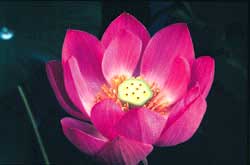
Lotus—for enhancing spiritual awareness; deepening meditative experience
I always begin my work with the client by bringing my own activity to a place of stillness. I sit in a comfortable position and take several minutes to become centered and quiet. Then I direct my attention to the client needing healing. At some point I receive an energetic image of the person and I then inwardly ask for relevant information about the client.
When I first began this type of work, my powers of focus and concentration were not advanced, so I learned to work in progressive layers. I continue to work in this way by asking simple questions like, “May I see color?” or “May I see the edge of the aura?” I also take note if my attention is drawn to a specific area of the body or if I see unusual manifestations of auric energy or related physical imbalances. For example, I might perceive an energy pattern zigzagging from an ankle across to a knee, over to a hip and then pouring out the shoulder. I might then discover that one of these places was where an injury originated, resulting in chronic pain.
Testing My Research and Developing a Baseline for Perception
Over a period of about three years, I shared my developing skill with trusted friends, inviting them to let me investigate their auric condition, or that of their children. In the beginning, I did not interpret, I just reported the qualities and colors I saw in the aura, in association with the physical body. One of these friends had an acquaintance who was very experienced in subtle seeing. This person was consulted for an interpretation or confirmation of what I was seeing. The connection was very helpful, giving me more confidence and helping me to build a ‘dictionary’ or repertory for my inner sensing investigations.
I also read other research about the aura and the chakras at this point. All the while, I was engaged in receiving regular bodywork, which I believe facilitated this skill. Through my own experience of bodywork, I could develop an extensive vocabulary to describe how various experiences felt in the body and how the space around me changed in quality. I also enlarged my terminology for sensing and describing emotional states associated with bodily consciousness.
Early on in this practice, I “looked” at people, with their permission, from a distance. The next phase of development was to examine a variety of people as they sat in front of me. Again, I solicited trusted friends, and I did no major interpretations. Over the course of time, my perceptions began to repeat themselves in different people. For example, I could discern the crown chakra, and note that it was a relatively predictable size and shape for most people. Also, certain phenomena would repeat themselves in a generalized group. For instance, young children under seven years of age usually wear lighter, more ethereal colors, and typically have a larger space in the upper area of their aura when compared to adults. By these methods of investigation, I was able to develop baselines for comparison and continue to build my own dictionary.
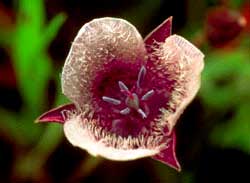
Star Tulip—for inner knowing from one's own meditative attunement
I think it is important to comment here that reading books which give glossaries for interpreting the aura can be helpful to get started, but eventually it is necessary to build a reliable internal dictionary. This is achieved by cultivating an inner sense for whether one's “radar” for filtering incoming information is “clean.” For example: I see the etheric body as magenta, although a well-known, highly skilled seer sees it as blue. It is likely that she perceives subtle bodies in a further form or different configuration. I am quite sure I see out to the astral field, so my method for seeing the etheric body could contain layers of other color which result in magenta, or I may be perceiving the etheric body in its more direct manifestation. As with any other process of perception, it is necessary to develop a baseline and a context for what one is observing.
Most important is my sense for the quality of the etheric body I am perceiving. I want to know whether it is a clear, vibrant color, of good size, and fully intact, with movement that is dynamic rather than sluggish. I would add here, that if it the etheric body is gray, or brown, then color becomes more important, and usually indicates a serious disturbance in vitality and over-all health.
Incorporating Flower Essences in Auric Healing
As I developed my subtle sensing abilities, I became acquainted with flower essence therapy. Because flower essences have their main impact on the subtle bodies, I sought to ‘test’ essences while doing auric reading. Upon completing the FES Practitioner Training Course, I have incorporated aura/energy reading as an important component of my work.
After reviewing the client’s information and before I see a client, I first consider many appropriate essences. During my first appointment, I do an aura reading to get a baseline for comparison. I usually start by looking for the “edge” of the auric field. I check its size, shape, whether it has a torn or evenly shaped edge, whether it is on the ground, and whether it is open or closed on the top. I then look inside the aura and take note of color, movement and energy patterns. I look at the client’s physical body and inspect all the major energy centers such as the chakras, and all the primary joints as well as the hands and feet. I observe the client and simply note if my attention is drawn to any one area of the physical body or the aura. If this is the case, I ask for information about what I am perceiving. I always finish by ‘listening’ for a core feeling. By doing this, I may receive information about a predominant emotional state in addition to the image I have perceived. For example, I may sense the client’s identity as a child at a pivotal moment in the life biography.
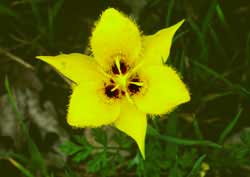
Yellow Star Tulip—for insight through social interaction with others, listening skills
Keeping in mind the information I have gathered from this baseline reading and my own inner sense of the situation, I then place stock bottles of flower essences into the client’s hand. I re-check the aura to see if the flower has a noticeable effect, or if the client’s emotional current has changed. After choosing what appear to be a number of resonant flowers, I build a combination of essences in the client’s hand, again inspecting each addition. This can be invaluable for the sensitive client who may not be able to handle emotional stimuli too rapidly. I gradually construct the flower combination by placing each bottle in the client’s hand, noticing tension levels rising or falling, or the aura shifting or changing size. The relief can be quite palpable when the proper supportive or soothing flower essences have registered in the client’s aura. On the other hand, sudden and unexpected emotion can color the room. I always solicit the client’s input during this investigative process, encouraging them to tell me anything, even if it appears as insignificant as itching in the palm of the hand. By having the client follow the session actively with me, I am also educating the client’s ability to become more conscious of changes in the auric field.
Examples of Flower Essence Signatures in the Aura
I have found the following flowers have relatively consistent signatures. These flowers may be a good place to start for practitioners who want to use subtle seeing as part of their flower essence therapy.
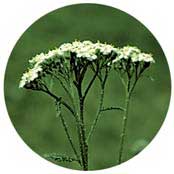
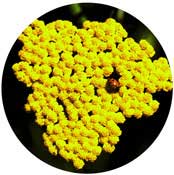
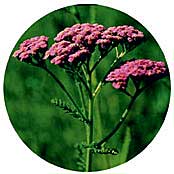
Yarrow – This is an excellent remedy for many emotionally or psychically absorbent clients. I always check the edge of the aura when testing Yarrow. This flower essence repairs breaks in the aura, closes the top of an open aura, and brings the aura down to the ground. These changes may not happen immediately but one can begin to discern movements of auric energy in the direction of closure and consolidation. Some clients carry large energy fields because of regular spiritual practices, while others have an energy field that is widened unconsciously. These latter individuals have not learned to provide proper boundaries for their aura and the Yarrow flower essence provides ideal containment. The quality of auric color can also be checked when testing Yarrow. Is the aura brighter, clearer, more intense, softer, and so forth? Golden Yarrow will tend to radiate more in the solar plexus while the Pink Yarrow usually stimulates the heart center.
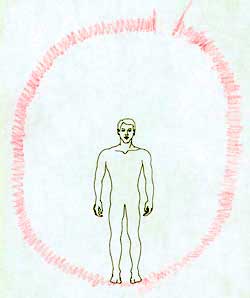

Walnut – I always check the eye area when testing Walnut. If Walnut is the appropriate energetic remedy, it will appear as though the client is wearing binoculars. The area of focus and clarity will be invigorated in such clients. I will also check the edge of the aura with Walnut. I have noted that clients who need containment flowers are typically either Yarrow or Walnut types.
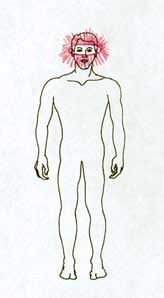
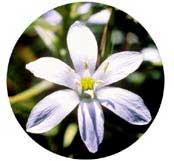
Star of Bethlehem
This is a flower essence that soothes deep-seated emotional pain and trauma and restores a connection with the core spiritual identity. I often see Star of Bethlehem ignite the space behind the client with light. I almost always notice an air change with Star of Bethlehem. In general, I usually associate a cool air change as a good sign and this can happen with any flower.
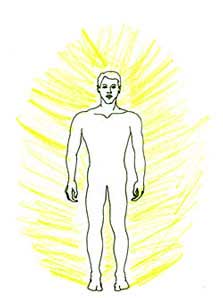
Using Star of Bethlehem: the back space lights up; air clean and cool
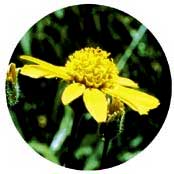
Arnica
This is another flower essence that heals past trauma by creating greater vibrancy and solar radiance. One can observe that Arnica "melts" obstructions in the body-mind complex. Look for movement in any area that appears to have an energy blockage. Since Arnica can heal past trauma, pay attention to emotional tones changing when you test this flower. Does the tone in the room become heavy or dense? Do you or your client feel uncomfortable or fidget? These can be signs that Arnica may be addressing past trauma that may be difficult for the client. Of course, stirring past trauma can happen with any flower. It would be at this point that you would use your discernment as a practitioner to judge whether or not this amount of healing aggravation is appropriate, whether a softening flower should be added, or whether it is wise to go more slowly still.
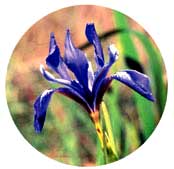
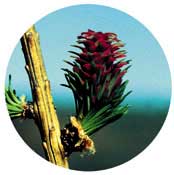
Iris and Larch – In addition to Arnica, these are also excellent flowers for releasing energy blockages, especially in the shoulder girdle. This area of the body is around the 5th, or the throat chakra where creative expression is most active.

Lavender and Angelica – These two remedies work in the higher chakras providing support for the spiritual circuitry in the nervous system. It is important to routinely check the upper energy centers and the aura from the shoulders up. Lavender is beneficial for closing an aura that is overly expanded on top. Check for delightful air change with Angelica. Angelica can create a wonderful sparkling in the aura and can also help straighten out a crooked crown chakra.
Heart Centered Flowers: Holly, Bleeding Heart, Yerba Santa, Nicotiana, Pink Yarrow, Pink Monkeyflower, Centaury, California Wild Rose, Borage
For all the flowers that work in the heart center I always check the chest area and often see the inner space immediately burst open. It appears that the first movement from these flowers is to create more spaciousness and receptivity for change within the heart center. It is important to investigate feeling tones when testing heart centered flowers. I always gaze at my client’s face to see if a new expression emerges. It is not as if their outer physical expression actually changes, it is an ‘under the surface’ expression. Pink is the most common color restored to the heart. While some chakra systems portray the heart center as green, the heart forces in the astral layer of the aura actually tend to be pink when they are healthy and vibrant.



When the right heart flowers are used, the emotional space softens and a palpable sense of relief can often be felt in the room. Centaury has a good ability to soften and encase the heart, helping to bring alignment with the solar plexus. Self-Heal flower essence stimulates the chest area also, and appears to ‘brace’ the heart center by providing more etheric support and structure.

Archetypal Flowers for the Client
Any flower can test as a major type remedy for the client, or one that will be pivotal to the healing journey. With these flowers, there is not usually a specific change in the aura, or in the emotional tone. Rather, there is an emerging vibrational field that seems to fill the entire room. It can be a good exercise to begin paying attention to fundamental flower essences like Mariposa Lily, California Wild Rose, Wild Oat, and Holly in order to recognize their unique signatures with each client.
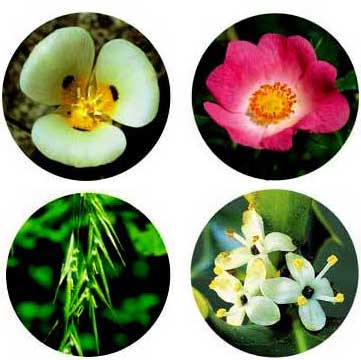
The Impact of Medications in the Aura
I have observed that standard pharmaceutical medications can mask the emotional current, making clear perception more problematic. This effect varies from individual to individual. It doesn’t necessarily block the client’s ability to have feelings, although sometimes I discern more activity in the mental field which does not circulate downward. In other words, a pharmaceutical medication may be keeping the client “in their head” about core feelings. My clients have also taught me that medications can sometimes narrow the range of emotions; the emotional vocabulary or the ability of the client to articulate feeling is much more limited.
Depression
This part of my inner dictionary is only beginning to develop. I have started to recognize some kinds of depression (usually episodic and not medicated). I usually see them only as far out as the emotional layer of the aura. The next major layer, which is the astral body, appears to be missing or collapsed inward – perhaps this is an energetic picture of the term, “depression” – the soul’s inner experience of being “deep-pressed.” Also, the emotional body lacks its own formation and is not elliptical, rather it is more closely drawn into and follows the shape of the physical body.
St. John's Wort
Furthermore, the emotional body has a swimming, undulating movement and appears thick and heavy in quality. Of course, many different flowers can address depression and each choice would depend upon the client. I select a variety of flowers that seem appropriate and test them on the client while checking for changes in the energy field. A small change can be very significant in cases of depression, because it could be that you will be working to change a long standing pattern. In a case where the depression registers in the aura this way, you may want to look at combining a flower for depression with a containment flower like Yarrow or Walnut to help reestablish the energy field. Another good consideration is St. John’s Wort which speaks so beautifully to both depression and circulation of inner light.
Concluding Remarks: A Gradual Path of Development
Subtle sensing of the human energy field is not the “special gift” that most of us have been told or taught that it is. It is more an underdeveloped aspect of our physical sensory system which we can choose to engage and develop, with practice, over time. With this refined use of one’s eyes, one’s ears, one’s heart, and one’s mind, we often discover that these “special gifts” were there all along, and perhaps we just weren’t paying a certain kind of attention. For those who have developed these skills, many will tell you that engaging this process is relatively easy. The more challenging aspect of this work is the deep inner trust of one’s knowing. This is where time can be helpful. Gradual development will lead to reliable understanding.
Read an in depth case profile:
Building a Container for Rachel: Resolving Depression Through Emotional Transformation
About Trish Mooney
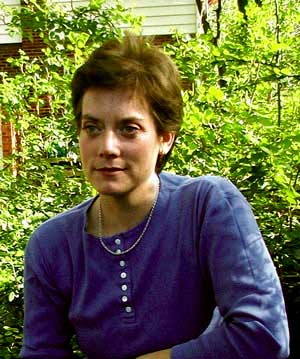 Trish Mooney has degrees in English and Dance. It was through her work as a dance and movement instructor that she discovered she could see aura and energy. She became a FES Certified Practitioner after attending the 1999 FES Practitioner Training Program. Trish maintains a private practice and can be reached attmooney2@msn.com. She is also a trained facilitator in consensus decision making. She lives with her husband and three children in Takoma Park, Maryland (a suburb of Washington, DC.)
Trish Mooney has degrees in English and Dance. It was through her work as a dance and movement instructor that she discovered she could see aura and energy. She became a FES Certified Practitioner after attending the 1999 FES Practitioner Training Program. Trish maintains a private practice and can be reached attmooney2@msn.com. She is also a trained facilitator in consensus decision making. She lives with her husband and three children in Takoma Park, Maryland (a suburb of Washington, DC.)
Bibliography
Andrews, Ted, How to See and Read Auras, Llewellyn Publications, 1991.
Brennen, Barbara, Hands of Light, A Guide to Healing Through the Human Energy Field, New York, Bantam Books, 1988.
Bruyere, Rosalyn, Wheels of Light, Chakras, Auras, and the Healing Energy of the Body, New York, Simon and Schuster, 1994.
Rosetree, Rose, Aura Reading Through All Your Senses, Sterling, VA, 1996.
Reprinted with the kind permission of the Flower Essence Society (see below). All photos provided by the Flower Essence Society with our thanks.
* * * * * * * * * * * * * * * * * * * * * * * * * * * * * *
“The Flower Essence Society (FES) is an international membership organization of health practitioners, researchers, students, and others interested in deepening knowledge of flower essence therapy. Originally founded in 1979 by Richard Katz, the society has been co-directed since 1980 by Patricia Kaminski and Richard Katz, who are married and professional partners.The Society promotes plant research and empirical clinical research on the therapeutic effects of flower essences, conducts training, certification programs, and seminars throughout the world as well as disseminating publications about flower essence and provides a communication & referral network for an estimated 50,000 active flower essence practitioners who are teaching, researching and practicing flower essence therapy in their healing work.”
The Flower Essence Society maintains a beautiful and informative website with an abundance of free research articles by & about practitioner research in the field and in depth case studies. You can make online donations at the website. You can also become a member in the society right online giving you access to an additional wealth of research essence profiles. Membership also includes access to the book, Flower Essence Repertory. The Repertory is a richly illustrated, cross referenced informative resource for anyone interested in Flower Essence therapies. Patricia and Richard also manage Flower Essence Services, which produces flower essences and herbal products at Terra Flora, their 17 acre biodynamic/organic garden and wildlife sanctuary in the northern Sierra Nevada foothills of Nevada City, California.
(Note: Jane Sherry & Curtis Lang, Satya Center Founders have been using the Flower Essence Services products for several years, and have found that they provide consistant, vital and exquisite flower essences and herbal products of a very high vibrational quality. They have a deep and profound effect personally and in their healing practice. FES very generously provides a discount for health practioners and their products are very affordable for the general public.
And, if you are interested in learning more about flower essences, reading up on groundbreaking research, flower profiles, flower affirmations, discounts on publications, practitioner referral network and member newsletters, I highly recommend investing a small amount of time and money in becoming a member of the Flower Essence Society. It costs only $25 per year, and is a valuable way to contribute your love and energy into healing yourself, your loved ones and our only home, Planet Earth.)
